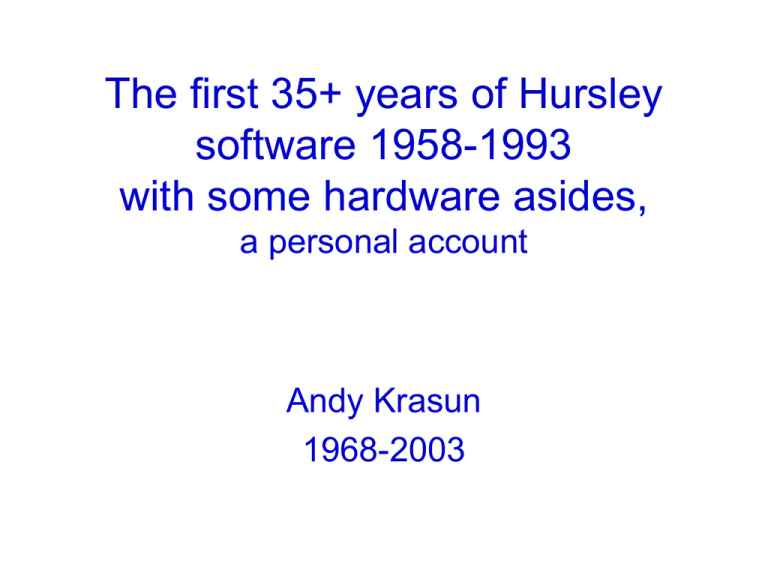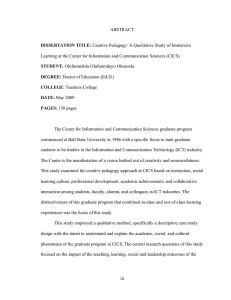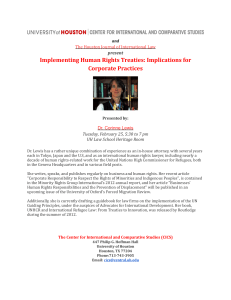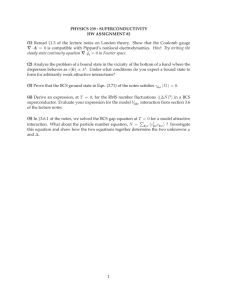The first 35+ years of Hursley software 1958-1993 with some hardware asides,
advertisement

The first 35+ years of Hursley software 1958-1993 with some hardware asides, a personal account Andy Krasun 1968-2003 Caveats • This is a personal view which has been looked at, but not verified as a paper, by friends and colleagues from Hursley • Any errors are mine, and I would welcome any corrections and additions • In an hour, I can only skim the subject • IBM is full of acronyms mostly TLAs or FLAs and even nested TLAs and FLAs! But the trouble is that the expanded version of these acronyms are probably as incomprehensible too! And sometimes tautologous BCS October 2006 Hursley House BCS October 2006 Hursley’s history - 2006 BCS October 2006 Background • IBM started to invest in UK development in mid 1950s – Excellent pool of talent which was less expensive than the USA – Predominantly engineers – IBM development arrived at Hursley on December 1,1958 • Worked mainly on special European projects • Scientific and Modulator Processor (SCAMP) • Overlapped I/O • Multiple machine architectures in IBM by 1962 – Commercial programmed in machine language and COBOL • 1401, 1403 supported by the COMMON user group • 704, 7040 supported by the GUIDE user group – Scientific programmed in machine language and Fortran • 709, 7090, 7094 supported by the SHARE user group • 1620 – Process control • 1710 BCS October 2006 Acronym Soup • • • • • • • • • • • • • • • Background PL/I-F compiler PL/I Checker and Optimiser (Optimizer) STAM 1,2,3,4, VTAM HMP CICS/VS and CICS DOS/VS REXX NDB IBM3730 and DISOSS CICS/MVS GDDM CICS/ESA OSI and CICS OS/2 PM CICS OS/2 and the rest of the CICS family BCS October 2006 Soup to Nuts • • • • • • • • • • • • • • • Background PL/I-F compiler PL/I Checker and Optimiser (Optimizer) STAM 1,2,3,4, Virtual Telecommunications Access Method Hursley Macro Project Customer Information Control System/VS and CICS DOS/VS Restructured Extended EXecutor Norman’s Data Base IBM3730 and DIStributed Office Support System Customer Information Control System/Multiple Virtual System Graphical Data Display Manager Customer Information Control System/Extended Systems Architecture Open System Interconnect and Customer Information Control System OS/2 Presentation Manager CICS OS/2 and the rest of the CICS family BCS October 2006 Competition • BUNCH based in the USA and selling worldwide – Burroughs, UNIVAC, NCR, CDC, Honeywell – Same languages as IBM with the addition of ALGOL • UK based – Ferranti, ICT, English Electric, LEO, STC – Same as above plus various Auto-coders BCS October 2006 IBM hardware • Proliferation of different architectures in IBM hardware and the subsequent software started ringing alarm bells • The “Solution” – System 360 announced in 1964 • A range of computers with the same instruction set (well almost) though not the same machine technologies • Models 20, 30, 40, 50, 65, 67 and 91 • 4K to 1M of memory • Various buffered peripherals – Communication controllers, removable disks and VDUs! • A set of operating systems to fit the box size – TOS, BOS – PCP, MFT and MVT to come later BCS October 2006 360 architecture • • • • • 32 bit aligned word 16 general purpose registers 4 float registers 24 bit addressing (31 bit on the Model 67) Hardware protection between regions ((address spaces), similar to processes) • Buffered I/O – Channels, really separate I/O processors – Access through a DCB (Data Control Block) incredibly overloaded for all devices (files, lines, terminals, etc.) • Software bundled with the hardware BCS October 2006 Hursley’s early involvement • 360 simulator, SUPPAK – Ran on a 7094 • Hardware – System 360 Model 40 • First microcode machine using Transformer Read only Storage (TROS) – System 360 Model 44 (Scientific instruction set) • First machine I ever saw a floppy disk on • Software – APEX, Random generator for the Production of EXecutable PL/I programs – PL/I F compiler John Fairclough BCS October 2006 PL/I, the ‘Betamax’ of programming languages • Language designed by the 3x3 committee – 3 from GUIDE, 3 from SHARE and 3 from IBM – Intended to take over from COBOL and FORTRAN and also be a systems programming language – No reserved keywords – Mix of • IF-THEN-ELSE, Character handling, “subroutines”, data structures from COBOL • ( + - * ) syntax, DO loops and mathematical built-in functions from FORTRAN • ; syntax, block structures, subroutines and scope for variables from ALGOL • and later – – – – – Integrated macro pre-processor Implicit declarations Pointers and dynamic storage allocation from machine language Record I/O Telecommunications access BCS October 2006 PL/I F compiler • Designed to run in a 64K machine (1965-6) • Software delivered in versions • Upward source compatibility was a key selling point • Written in pure assembler language • Shipped as part of the operating system • PL/I F Version 4 shipped in 1968 BCS October 2006 PL/I follow-on • By PL/I F Version 3, it was decided that new compilers were needed because of spaghetti (non-structured) code and the now discernable differing objectives of: – Optimised run time – Increased programmer productivity (if you were lucky you might get three runs a day) • So the concept of a pair of compilers the Pl/I Optimiser and PL/I Checkout with unified run-time control blocks and libraries was born – In fact there were to be two pairs: 42K - DOS 100K - OS Checkout Böblingen Hursley Optimiser Hursley Boulder, CO BCS October 2006 PL/I Optimiser • Written in optimised assembler macros to run in 44K using typewriter terminals • Prototype was the F compiler • Team built from F compiler personnel • Objective was to be 50% faster than the F compiler • Run-time did this through by-passing operating system services – Getmain/Freemain(Getmem/Freemem) especially for the stack – Buffered I/O only when buffer was full • Also much better code generation phases – Register allocation – More inline code • Shipped as a Program Product BCS October 2006 PL/I Checkout Version 1 • Written in BSL( a proprietary PL/I subset optimised for systems programming, later renamed PLS, PLAS and then PLX) • First objective was to “compile” 4 times faster than the F compiler so find syntactic and semantic errors more cheaply • Second objective was to find errors and report them in source language terms with the correct statement number • Use the common PL/I run-time library • Provide the ability to link with PL/I Optimiser compiled code • Prototype built: interpretive • Team built from some F compiler personnel, rest were new graduates – Around a hundred maths graduates were recruited in 1968 (about 10% of the UK output) of which 20 worked on the Checker • Shipped as a program product BCS October 2006 PL/I Checkout Version 1 • First objective – Did this by having only three passes • Source errors shown with source “ Unknown keyword ‘RAED ? FILE(..’ – Large amount of fix-up • Respelling ‘RAED’ respelled ‘READ’ • Ability to format source – Private loading mechanism to avoid operating system – Output was a half-word text, “H-text “ | Operator | sub-code | optional length | dictionary reference(s) | – c.f. ITEXT, PCODE • Second objective – Un-initialised variables – Bad pointers, 4-byte standard versus 16 byte which carried descriptor data BCS October 2006 PL/I Checkout Version 2 • Used Time sharing Option (TSO) to provide terminal I/O • Major new technology – Allowed additional statements, including declarations, to be added and executed during run-time with incremental translation – e.g. 120 PAYMENT=0; /* Initialise */ – Also allowed source to be saved including the updates and formatted as well BCS October 2006 STAM 1,2,3,4, VTAM • Single terminal access method • Planned to supersede Basic Telecommunications Access Method and Queued TAM – Session based • Built using CLEAR/CASTER – First IBM development system to only use a video screen – Written in PL/S • Later to become DOS Virtual TAM • VTAM was the primary product to implement Systems Network Architecture (SNA) BCS October 2006 QTAM BTAM T C A M HMP • Hursley macro processor • Attempt to build an extensible language – Some similarities with Simula/C++ • Moved to New York Programming Centre in 1972 • Project wound up in 1975 • Leads later into EXEC CICS BCS October 2006 FS • Even after the 360 consolidation there were other machines, mainly 1130s and System 3s from GSD • Concept for the series was a single level store machine with a built in database to run on an interpretive intermediate text very similar to the Checkout’s H-text – This then implied that all languages should compile to this text and have a common runtime environment and subroutine library – So plans were made to consolidate all compilers and run times in Palo Alto, CA – We were not happy! BCS October 2006 So CICS came to Hursley • Hursley had been offered a choice three products to replace PL/I Application BATS BTAM – Data Dictionary – CICS – Low end time sharing system (VSPC) • Malcolm Beaver, an IBM UK manager, was moved into Hursley to take over the Programming Centre – He had previously built British Administrative Terminal System in London which was used by most of the UK banks • high level interface to BTAM – SS and BSC support • basic CICS competitor – He chose CICS • Program product – Major competitor was SHADOW BCS October 2006 CICS basic architecture • ‘Invented’ by Ben Riggins in Chicago in late 1960’s • Single region/address space • Internal scheduler to avoid operating system overhead • Resources Application Application 3 4 Application2 Application 1 TCT3 TCT2 TCT1 BMS ICP TDP PCP FCP TSP TCP ZCP Access Methods Operating System – Defined by table entry, assembled for execution – rather nasty assembler macro programming interface for all languages (c.f. method) – Device independence through BMS • Co-operative application program design BCS October 2006 IMS basic architecture • Hierarchical data base ‘invented’ at Rockwell Application Application 3 4 Application2 Work area 1 DC address space Application Application 3 4 Application2 Application 1 MFS DB DL/I Queue manager Access Methods Operating System BCS October 2006 – – – – Transactional One application region Simple CALL interface No storage protection between tasks – Program product • One address space for terminals – Feature – Device independence through MFS Early CICS’ • 1.2 – SNA device support(LU0) • 1.3 Applications – – – – EXEC CICS CICS Applications Other applications Mirror Table EXEC CICS CICS EXEC CICS CICS EXEC CICS Dynamic transaction backout File control rewrite Program isolation • 1.4 – Transparent access to remote Table data (Function shipping) through communications access method • Files • Queues File BCS October 2006– Base debugger (EDF) Early CICS’ cont. Applications Relay EXEC CICS EXEC CICS CICS CICS • 1.5 – Transaction routing • Major increase in resilience • 1.6 – APPC Applications Applications EXEC CICS EXEC CICS CICS CICS • Application to application(LU6.2) • One phase commit • 1.6.1 – Start of 31 bit addressing BCS October 2006 Early CICS’ cont. • 1.7 – APPC Application Application 3 4 Application2 Application 1 • 2 phase commit – File control rewrite – Terminal auto-install TCT3 TCT2 TCT1 EXEC CICS BMS ICP TDP PCP FCP TSP TCP ZCP • Major storage relief • Large cost of table generation removed And then the challenges came! Access Methods Operating System BCS October 2006 REXX • Restructured eXecutor – Designed firstly by Mike Cowlishaw – System independent – After much interaction, all by e-mail, the follow-on Restructured eXtended eXecutor was created • Documentation before implementation – PL/I based syntax – Can be used in a variety of ways • Personal programming, tailoring commands, macro language and for protoyping – Fist integrated into VM/CMS BCS October 2006 Norman’s DB • Chris Date worked on DB extensions for PL/I • Peter Titman and Norman Winterbotham had defined an entity-set/binary relational DB architecture – Major conflicts with Ted Codd • Norman then built the Personal Binary Relational DB with an integrated User Interface which would interactively construct databases with reports – Still in use today BCS October 2006 3730 • A Hursley programmed 3790 to perform shared office function for up to 24 users – Size of a large kitchen table – Not enough memory or engine speed (disk was a Hursley 62M Gulliver) – Terminals were reworked 3277s with new internals to do word-spill etc. – Pattern letters – Connected to a mainframe using SNA LU0 and LU1 protocols • Other hardware office products were coming to market – Displaywriter- stand alone workstation - LU6.2 connection – Snowball- TP connected fax machine - LU6.2 connection – IBM6670- TP connected copier/printer - LU4 connection • Centralised Office system required – DISOSS which ran on CICS and IMS – Introduced CICS licences into a 1,000 IMS shops because IMS had decided they would not implement LU6.2! BCS October 2006 3730 text formatted to IBM6670 BCS October 2006 CICS/MVS Primary Secondary C I C S VTAM MVS C I C S VTAM MVS • Major competition was Tandem Non-Stop • XRF was created – Primary and back-up – Switch in Network Control Program when primary fails to respond • Increased availability because no network restart Data – Shared DASDI for data Communications Controller NCP • Built offsite in Millbrook BCS October 2006 Meanwhile back in Hursley • CICS restructure – Kernel • Domains • Storage control • Dispatcher – Use of Z • Saved approximately 9% of development cost • Probably 10 times that in service costs • Queen’s Award to Industry • Shipped as Version 3 BCS October 2006 GDDM • A concerted attempt was made very late 1970s to amalgamate the various mapping technologies – – – – CICS - BMS IMS – MFS ISPF – MVS Died a death • A simpler product was created with its own API for CICS and IMS to support 3270 green screen and the upcoming colour terminal the 3279 with proper graphical support – Technology was programmed symbol sets – Extended for printers – The key addition was the Interactive Chart Utility (ICU) which took numerical input • Drew graphs and various types of charts • Produced printed reports BCS October 2006 OSI and SNA Presentation Transaction services Application Functional management Session Data Flow Transmission Transmission Network Path control Data Link Data Link Physical Physical • Bottom layers very similar at top of level 3 • Top of level 5 is where CICS is • Each OSI level architected with defined interfaces • OSI connectivity needed for government tender • Levels 1, 2 and three existed • Bought in software for levels 4 and 5 – Beautifully architected as per the standard – A performance nightmare BCS October 2006 Eventual solution X400 Application ---------------------- DISOSS CICS Level 4 OSNS OTSS X25 Lower levels VTAM Operating System MVS Level 5 It worked Wasn’t very pretty We were able to bid BCS October 2006 GWRobinson and CICS managers and senior techies BCS October 2006 OS/2 Presentation Manager • In the beginning was DOS with many of the same challenges as an early CICS – Memory constraints – Not enough cycles – Co-operative program design • IBM and Microsoft decided to work on a follow-on OS/2 which would alleviate the original deficiencies • Development in three places – Boca Raton, FL – hardware and part of the OS – Hursley – Presentation Manager – Redmond, WA – software • Design of PM had learnt from GDDM and associated hardware • Applications needed to be designed round an interrupt loop so mouse movements were ‘immediately’ handled • OS/2 was late… • Meanwhile Windows 3 was being developed quietly in Redmond and was ready when theIntel386 hit the market • So the rest is history! BCS October 2006 Message and Queuing • TCAM was widely used in the Brokerage business with messages being written to disk for integrity • IBM decided to stabilise TCAM to reduce development cost because much of the function duplicated the VTAM function • The standard Task Force was assembled • After customer visits to Wall Street the question was “Where is the TCAM follow-on?” – so MQ was born BCS October 2006 The rest of the CICS family and CICS OS/2 • CICS family expanded in the late 80’s – CICS AIX, CICS 400, CICS OS/2 and later the CICS client – Different technologies used for the implementation • AIX – existing software blocks SFS, DCE etc. • AS 400 – built from scratch • CICS DOS soon to be CICS OS/2 bought in from a small vendor – – – – Written in COBOL BTRIEVE as file manager Hardware protection between applications Conflicting requirements for a distributed server or client » Fell between the two stools at the beginning » Led to a cut down version becoming the CICS client in long a weekend in Millbrook – Most successful, in number terms, over a third of a million sold BCS October 2006 Summary • There is so much I have had to leave out – VDL, SNATAM, SL1 (SIGMA), SAA, DPS, PC3270 G and GX etc. – IBM5444, Functional memory, Model 44, IBM3250, Model 135, IBM8775 etc. – Service teams, test teams, planning teams and the marketing teams • We should have taken notice of Moore’s law – 20/20 Hindsight is a wonderful thing • The cartwheel of technology and the ensuing cartwheel of repeated errors – One can and should learn from history • Hursley was, and is, a great place to have a career BCS October 2006 Moore’s Law • Moore's original statement can be found in his publication "Cramming more components onto integrated circuits", Electronics Magazine 19 April, 1965 • “The complexity for minimum component costs has increased at a rate of roughly a factor of two per year ... Certainly over the short term this rate can be expected to continue, if not to increase. Over the longer term, the rate of increase is a bit more uncertain, although there is no reason to believe it will not remain nearly constant for at least 10 years. That means by 1975, the number of components per integrated circuit for minimum cost will be 65,000. I believe that such a large circuit can be built on a single wafer.” BCS October 2006




